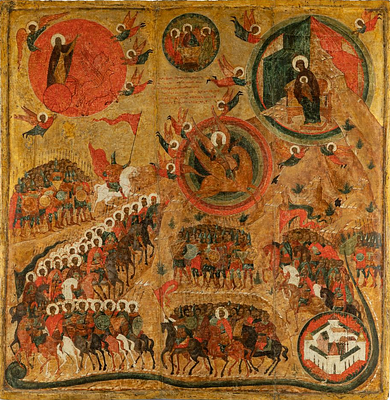Russian school, 17th century. Silver oklad, 17th century. "Mother of God with Infant Jesus and selected saints". Tempera on panel.
Lot 41
About Seller
Setdart Auction House
Carrer Aragó 346
Barcelona
Spain
Setdart Subastas was born in 2004 and is currently the first online art auction in Spain with solidity, prestige and reliability guaranteed by our more than 60,000 users. Setdart has a young, dynamic and enterprising team ready to successfully manage the purchase and sale of art works through custom...Read more
Estimate:
EUR€8,000 - EUR€10,000
$8,333.33 - $10,416.67
Absentee vs Live bid
Two ways to bid:
- Leave a max absentee bid and the platform will bid on your behalf up to your maximum bid during the live auction.
- Bid live during the auction and your bids will be submitted real-time to the auctioneer.
Bid Increments
| Price | Bid Increment |
|---|---|
| EUR€0 | EUR€10 |
| EUR€200 | EUR€25 |
| EUR€500 | EUR€50 |
| EUR€1,000 | EUR€100 |
| EUR€3,000 | EUR€200 |
| EUR€5,000 | EUR€500 |
| EUR€10,000 | EUR€1,000 |
| EUR€20,000 | EUR€2,000 |
| EUR€50,000 | EUR€5,000 |
About Auction
By Setdart Auction House
Sep 23, 2021
Set Reminder
2021-09-23 10:00:00
2021-09-23 10:00:00
America/New_York
Bidsquare
Bidsquare : RUSSIAN ICONS
https://www.bidsquare.com/auctions/setdart-auction-house/russian-icons-7431
Setdart Auction House sofia@setdart.com
Setdart Auction House sofia@setdart.com
- Lot Description
Russian school, 17th century. Silver oklad, 17th century. "Mother of God with Infant Jesus and selected saints". Tempera on panel. Measurements: 70 x 61 cm. The icon of interest represents the Virgin Mary seated on the throne, holding the Child Jesus on her knees. At the back of them are two archangels, Gabriel and Michael, distinguished by their reddish wings, holding the white curtain. In the outer frame of the icon are representations of various saints. Among them are: Saint John the Baptist in the upper left corner; Saint Nicholas the Miracle-Maker in the upper right corner. In the lower corners are depictions of the martyr brothers Boris and Gleb. There are six figures in the upper and lower registers of the frame. At the top are Boris and Gleb, and Sergiy Radonezhskiy, the figure on the left. In the lower row are two female figures, Paraskevi of Iconium with a red mantle, Anastasia of Sirmium with a green mantle, and between them another Christian martyr. The depiction of the seated Virgin and Child is widely known in the Orthodox world under the name "Panachranta", and has similar features to the prototype "Odighitria" in depicting the faces of the Virgin and Child embracing, and with the faces side by side. The central image of the auctioned icon features the iconography typical of Panachranta, with the Virgin Mary seated on the throne, holding the Christ Child on her knees. The throne symbolises the majesty and royal power of the Mother of God. This prototype of the Virgin Mary and Child developed in the Byzantine Empire between the 11th and 12th centuries, and has been known in Russia since the 13th century. In compositional terms, this ancient icon presents one of the most particular features of Orthodox iconography, which is the reverse perspective. The throne, on which the Virgin rests, is depicted in such a way that the viewer can see it from several points of view at once. The idea behind the reverse perspective is not so much to represent a physical object from the most realistic and plausible point of view, but to convey the moment and the space in which the scene takes place with maximum depth, i.e. to present the objects on the two-dimensional support in such a way as if they were viewed from all points of view at the same time. The composition also focuses on the viewer's gaze, and on the importance of the viewer being somehow part of the interior of the image. The same idea is at the basis of Cubist painting, for example. This icon is decorated with silver oklad, the decorative metal plate that covers part of the icon. This embossed silver decoration shows signs of antiquity, but was added to the icon at a later date. A curious detail of this icon is that the oklad, instead of being a continuous plate, leaves the background of the Virgin visible, and instead of being enveloped in silver light, she has only the nimbus decorated with metal.
- Shipping Info
-
In-house shipping available. Please inquire at admin@setdart.com.
-
- Buyer's Premium



 EUR
EUR CAD
CAD AUD
AUD GBP
GBP MXN
MXN HKD
HKD CNY
CNY MYR
MYR SEK
SEK SGD
SGD CHF
CHF THB
THB
















